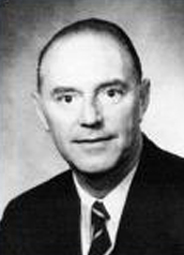
Harry Bolton Seed was known internationally for his understanding of soil behavior during earthquakes and for sharing that expertise through teaching and consulting. During his career Seed made significant contributions in the fields of structural and geotechnical engineering, highway engineering, and earthquake engineering. A native of England who became a U.S. citizen, Seed received the National Medal of Science, the nation's highest scientific honor, from President Reagan in 1987.
Harry Bolton Seed was born on August 19, 1922. The son of a cotton mill foreman, Harry spent his childhood in the heart of the industrial center of Lancashire. There he excelled in sports and mathematics, choosing a scholarship to King's College, London University over a professional soccer career. Seed's studies were interrupted by the war, where he served as a lieutenant in the army. After military service Seed returned to his studies and completed a PhD in structural engineering by 1947. During this period Seed captained the University of London's soccer team, and was selected as captain of the All-England team.
Shortly after completing his degree, Seed heard about the cutting edge work being done on soil mechanics by Karl Terzaghi and Arthur Casagrande . Acutely aware of the significance of the new field to his understanding of structures, Seed left London and received a second degree in soil mechanics from Harvard under the tutelage of the two innovative scholars. His Harvard education was followed by a year as a foundation engineer for the Boston based Thomas Worcester, Inc.
In 1950 Seed joined the civil engineering faculty at the University of California, Berkeley, where he would spend the next forty years as a teacher, researcher, and consultant. He helped to build the geotechnical engineering department at Berkeley into one of the largest and most respected in the world, and in 1965 he became chairman of the entire Civil Engineering Department. He had a gift for bringing colleagues together from a variety of geotechnical engineering backgrounds, including geological engineering and rock mechanics, soil mechanics, and foundation engineering.
Seed's early work on the mechanics of pile formations formed the basis for modern concepts of pile-soil interaction. But his greatest achievement was the introduction of the field of geotechnical earthquake engineering in 1960. The new field addressed issues such as the liquefaction of saturated sands during episodes of cyclic loading, the strength characteristics of cohesionless soils, and the mechanics of landslides during earthquakes. Seed's work helped others determine the influence of soil conditions on building damage when and if an earthquake occurred. Naturally, Seed's new field had far-reaching practical applications.
Seed consulted a variety of companies and government organizations on the designs of earthquake resistant earth dams, nuclear power plants, coastal buildings, and structural foundations. He investigated major disasters, such as the 1971 San Fernando earthquake in California, the 1976 failure of the Teton dam in Idaho, and the 1985 Mexico City earthquake, and developed design procedures that could be employed to help prevent similar occurrences in the future and protect generations to come.

